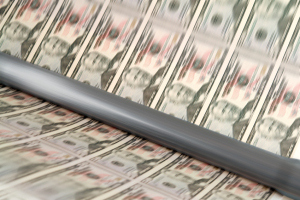By Steven Cochran, Gainesville Coins [1]
In a primitive barter economy, tangibles become currency. DRG and I store a variety of tangible items just in case an economic collapse occurs and bartering is necessary. One of those assets being junk silver. Not only is it recognizable as legal tender, it holds real, intrinsic value – unlike fiat paper money printed out of thin air.
Junk silver has long been considered the de facto barter currency in case of a break-down of society. That was certainly a no-brainer back in the days when junk silver sold for less than spot price, but perhaps its time to re-assess the situation. (Of course, you should periodically re-assess every aspect of your survival plans, in case they need adjustment due to changing conditions.) With demand for junk silver now causing it to trade for well over a dollar an ounce over spot, it may be time to diversify into pure silver rounds. In this article, we will review the advantages and disadvantages of both .999 silver rounds [3] and junk silver.
Silver Rounds:
Advantages
One ounce silver rounds give you more silver for your dollar. One oz .999 fine generic silver rounds are generally selling for 99 cents or lower an ounce, and many large distributors have tiered pricing levels to save you even more. Junk silver can sell for twice the premium of a bulk buy of 1 oz rounds. Even 1/2 oz or 1/4 oz rounds can be a better buy per-ounce than junk. Silver rounds also have their weight and purity stamped directly on each one. This may make bartering simpler with non-preppers.
Disadvantages
Some people, especially fellow preppers, may be wary of silver rounds, not trusting privately-minted silver as much as government-minted 90% junk silver. This is a reason some preppers pay the extra premium and buy 1oz American Silver Eagles [4]. Some rounds have silly, or pop culture designs, which may reduce the willingness of someone to take them in barter.
Junk Silver:
Advantages
Junk silver is readily recognized by fellow preppers, and those who are old enough to remember pre-1965 silver coinage. If you have the time and inclination to go through your stack, you may even find some coins worth more than melt value. The fact that it is old U.S. currency reassures many people worried about fake rounds or bars.
Disadvantages
Non-preppers may not accept junk silver, except at face value (that could change, depending on how long the economic disruptions last.) The “$1 in face value = .715 oz of silver” will seem strange to someone who has never heard of it, and might lead them to be suspicious of your offer.
Even at a discounted actual silver weight (ASW) of .715 troy ounces per $1 face value, some junk silver coins are so worn that you may not be getting full value (especially with Barber dimes and quarters.) If things get so bad that there’s a break-down in Federal authority, and the barter economy lasts for a long time, people will start acquiring scales, and weighing coins before accepting them, like the old days.
Junk and Rounds BOTH Come Under 1099B Rules!
Contrary to popular opinion, sales of junk silver is not exempt under 1099B reporting rules. Only modern U.S. legal tender bullion (Silver Eagle, Gold Eagle, Gold Buffalo) is not reportable.
The minimum reportable amount of junk silver under IRS rules is $1000 face value. That’s only 715 oz. of silver. Silver bars [5] and rounds are reportable at 1000 oz. or more. That’s almost 40% more silver that can be sold to a dealer or exchange without being reported. Of course, this only applies to sales under “normal” circumstances. If things go south, you’ll be bartering with your silver instead of selling it to a company for fiat currency.
Conclusion
Everyone’s situation is different. Take into consideration who you expect to be bartering with, and what you will be bartering for, in different possible scenarios. Your course of action will likely be different during a short-term, temporary disruption such as a natural disaster or month-long bank lock-out, than during a systemic societal collapse.
You may want to consider keeping some 1 oz .999 silver rounds or bars on-hand for larger barter deals, or go the other direction and stack junk halves, and use half- and quarter- ounce rounds for small transactions. The silver content is stamped right on the round, so it’s less complicated than explaining the “silver content to face value” ratio on 90% silver to someone who is unfamiliar with junk coins.
Silver is silver, but it’s up to you to decide the right balance of cost and liquidity for your specific purposes.
[Below is an infographic Gainesville Coins provided that may be useful to some of you.]


